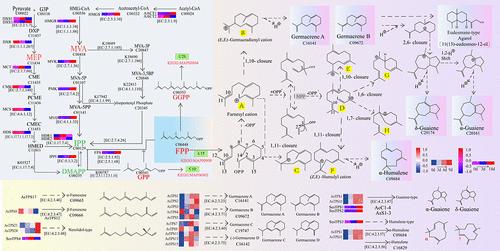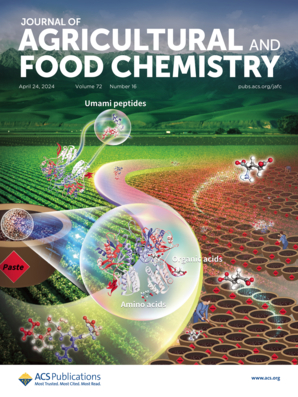沉香中的倍半萜类化合物:生物合成、微生物诱导和药理活性
IF 5.7
1区 农林科学
Q1 AGRICULTURE, MULTIDISCIPLINARY
引用次数: 0
摘要
沉香源于水曲柳属,在整个亚洲被广泛用于香水、传统医药和文化习俗中。沉香富含萜烯,尤其是倍半萜,被认为是其稀有而精致香味的来源。本综述整合了近期有关沉香中倍半萜生物合成的研究,以及真菌对这些过程的影响,并讨论了沉香倍半萜的潜在药用价值。本综述首先阐明了倍半萜的一般生物合成过程,并确定了参与沉香倍半萜生产的主要酶和转录因子。本综述还概述了与沉香木相关的真菌,并重点介绍了共生真菌如何刺激沉香木和倍半萜的生产。然后,我们仔细研究了倍半萜的药理特性,强调了它们的抗炎和抗菌作用,这些作用与细胞信号通路(如 NF-κB 和 MAPK 通路)密切相关。此外,我们还回顾了沉香精油抗抑郁的潜在治疗功效,这与压力相关的神经化学和荷尔蒙途径的调节有关。本综述还探讨了沉香可持续生产所面临的挑战,强调了过度采伐和栖息地丧失等问题,同时讨论了在沉香生产中利用微生物支持野生资源生态保护的潜在策略。通过增进我们对沉香和倍半萜特性的了解,我们提出了沉香研究未来应用和可持续发展的潜在方向。本文章由计算机程序翻译,如有差异,请以英文原文为准。

Sesquiterpenoids in Agarwood: Biosynthesis, Microbial Induction, and Pharmacological Activities
Agarwood, derived from the Aquilaria genus, is widely utilized in perfumery, traditional medicine, and cultural practices throughout Asia. Agarwood is rich in terpenes, especially sesquiterpenes, which are considered to be the source of its rare and exquisite fragrance. This Review consolidates recent research on sesquiterpene biosynthesis in agarwood and the influence of fungi on these processes, alongside a discussion of the potential medicinal value of agarwood sesquiterpenes. This Review commences by elucidating the general biosynthesis of sesquiterpenes and identifying the main enzymes and transcription factors involved in the production of agarwood sesquiterpenes. This Review also summarizes the fungi associated with agarwood and highlights how commensal fungi stimulate agarwood and sesquiterpene production. We then scrutinize the pharmacological properties of sesquiterpenes, underscoring their anti-inflammatory and antimicrobial effects, which are closely linked to cellular signaling pathways, such as the NF-κB and MAPK pathways. Additionally, we review the potential therapeutic benefits of agarwood essential oil for its antidepressant properties, which are linked to the regulation of stress-related neurochemical and hormonal pathways. This Review also addresses the challenges of sustainable agarwood production, highlighting issues such as overharvesting and habitat loss while discussing the potential strategy of harnessing microbes in agarwood production to support the ecological preservation of wild resources. By advancing our knowledge of agarwood and sesquiterpene characteristics, we propose potential directions for the future application and sustainable development of agarwood research.
求助全文
通过发布文献求助,成功后即可免费获取论文全文。
去求助
来源期刊
CiteScore
9.90
自引率
8.20%
发文量
1375
审稿时长
2.3 months
期刊介绍:
The Journal of Agricultural and Food Chemistry publishes high-quality, cutting edge original research representing complete studies and research advances dealing with the chemistry and biochemistry of agriculture and food. The Journal also encourages papers with chemistry and/or biochemistry as a major component combined with biological/sensory/nutritional/toxicological evaluation related to agriculture and/or food.

 求助内容:
求助内容: 应助结果提醒方式:
应助结果提醒方式:


